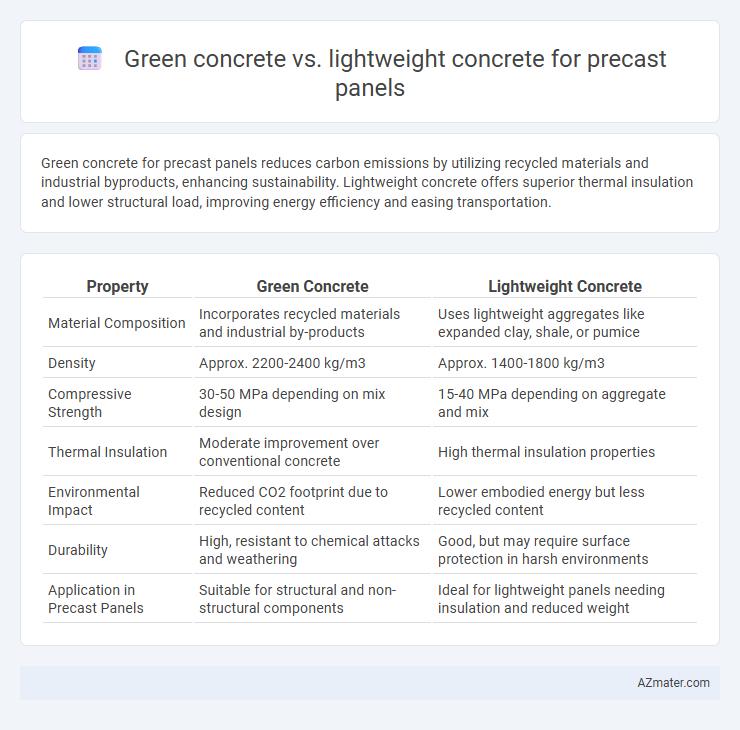Green concrete for precast panels reduces carbon emissions by utilizing recycled materials and industrial byproducts, enhancing sustainability. Lightweight concrete offers superior thermal insulation and lower structural load, improving energy efficiency and easing transportation.
Table of Comparison
| Property | Green Concrete | Lightweight Concrete |
|---|---|---|
| Material Composition | Incorporates recycled materials and industrial by-products | Uses lightweight aggregates like expanded clay, shale, or pumice |
| Density | Approx. 2200-2400 kg/m3 | Approx. 1400-1800 kg/m3 |
| Compressive Strength | 30-50 MPa depending on mix design | 15-40 MPa depending on aggregate and mix |
| Thermal Insulation | Moderate improvement over conventional concrete | High thermal insulation properties |
| Environmental Impact | Reduced CO2 footprint due to recycled content | Lower embodied energy but less recycled content |
| Durability | High, resistant to chemical attacks and weathering | Good, but may require surface protection in harsh environments |
| Application in Precast Panels | Suitable for structural and non-structural components | Ideal for lightweight panels needing insulation and reduced weight |
Introduction to Green Concrete and Lightweight Concrete
Green concrete incorporates industrial byproducts like fly ash, slag, or recycled aggregates to reduce environmental impact while maintaining structural integrity in precast panels. Lightweight concrete uses low-density aggregates such as expanded clay or shale to reduce panel weight and improve thermal insulation without compromising strength. Both materials enhance sustainability and performance in precast panel applications, offering distinct benefits based on project requirements.
Material Composition: Green vs Lightweight Concrete
Green concrete incorporates industrial by-products such as fly ash, slag, and recycled aggregates, reducing the use of traditional Portland cement and lowering carbon emissions. Lightweight concrete utilizes expanded clay, shale, or slate aggregates, which significantly decrease density and improve thermal insulation properties. Both types modify material composition to enhance sustainability and performance, but green concrete prioritizes eco-friendly materials while lightweight concrete focuses on weight reduction and structural efficiency.
Sustainability and Environmental Impact
Green concrete for precast panels integrates recycled materials and industrial byproducts like fly ash or slag, significantly reducing carbon emissions and natural resource consumption compared to traditional mixes. Lightweight concrete, often incorporating expanded clay or shale aggregates, offers enhanced thermal insulation and reduced structural load, indirectly lowering energy use during the building's lifecycle. Both materials promote sustainability, but green concrete's direct replacement of cement and waste reduction present a more substantial environmental benefit in precast panel applications.
Strength and Durability Comparison
Green concrete for precast panels incorporates recycled materials and supplementary cementitious materials, enhancing sustainability without compromising compressive strength, which typically ranges from 30 to 50 MPa. Lightweight concrete, made with low-density aggregates like expanded clay, offers reduced weight but typically has lower compressive strength, ranging from 15 to 35 MPa, depending on mix design. In terms of durability, green concrete exhibits improved resistance to chemical attacks and reduced permeability due to dense microstructure, whereas lightweight concrete may have higher porosity, potentially affecting long-term durability under aggressive environmental conditions.
Weight and Ease of Handling
Green concrete for precast panels offers significantly lower density due to the use of recycled aggregates and industrial byproducts, resulting in reduced weight that enhances ease of handling and transportation. Lightweight concrete, typically composed of expanded clay, shale, or pumice aggregates, provides excellent weight reduction while maintaining structural integrity, facilitating faster installation and decreased labor costs. Both materials improve handling efficiency, but green concrete emphasizes environmental benefits alongside weight savings in precast panel applications.
Thermal and Acoustic Performance
Green concrete for precast panels exhibits enhanced thermal insulation due to its incorporation of recycled materials and supplementary cementitious components, resulting in lower thermal conductivity compared to traditional mixes. Lightweight concrete offers superior acoustic performance by effectively dampening sound transmission owing to its porous structure and lower density, making it ideal for noise reduction in building applications. Both materials contribute to energy efficiency and occupant comfort, with green concrete optimizing thermal regulation and lightweight concrete excelling in sound insulation.
Cost Considerations for Precast Panels
Green concrete for precast panels typically offers savings through the use of recycled materials and reduced cement content, lowering raw material costs and environmental fees. Lightweight concrete, while providing benefits in reduced transportation and installation expenses due to its lower density, may incur higher initial costs from specialized aggregates and admixtures. Cost considerations for precast panels hinge on balancing material expenses with lifecycle savings, where green concrete can enhance sustainability and reduce long-term costs, and lightweight concrete improves handling and structural efficiency.
Manufacturing and Installation Processes
Green concrete for precast panels involves using recycled materials and industrial by-products, reducing carbon emissions during manufacturing compared to traditional lightweight concrete. The manufacturing process requires careful mix design to ensure durability and strength while maintaining sustainability, often utilizing supplementary cementitious materials like fly ash or slag. Installation of green concrete panels benefits from enhanced environmental certifications and similar handling procedures as lightweight concrete, but may demand slightly longer curing times to achieve optimal performance.
Applications in Precast Panel Construction
Green concrete, formulated with recycled materials and industrial by-products, offers enhanced sustainability and durability for precast panel construction, reducing carbon footprint while maintaining structural integrity. Lightweight concrete, incorporating aerated or expanded aggregates, provides excellent thermal insulation and reduces the overall weight of precast panels, making it ideal for high-rise building facades and modular construction. Both types optimize performance based on specific project requirements, with green concrete preferred for eco-friendly applications and lightweight concrete favored for structural efficiency and ease of handling.
Future Trends and Innovations
Green concrete for precast panels incorporates recycled materials and low-carbon cement alternatives, significantly reducing environmental impact and meeting stringent future sustainability standards. Lightweight concrete innovations focus on enhanced strength-to-weight ratios and thermal insulation, promoting energy efficiency and ease of installation in evolving construction practices. Emerging trends include the integration of nanomaterials and 3D printing to optimize durability and customization in both green and lightweight concrete precast panels.

Infographic: Green concrete vs Lightweight concrete for Precast panel
 azmater.com
azmater.com